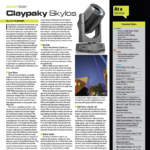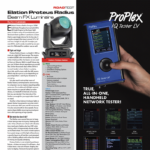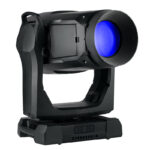Last year, Martin Professional unveiled the first in their series of new lighting fixtures, the Viper. It’s an extremely bright, hard-edged lighting fixture with a lot of functions. Since then, Martin has unveiled the Viper AirFX. It appears that somebody has finally stepped up and built a lighting fixture that’s designed for the rock ‘n’ roll lighting designer. By that, I mean a light that caters to how we can shape and color a light beam, as opposed to primarily caring about the subject the light would be illuminating or shining a texture on.
A Hybrid Fixture
First of all, this product is almost the exact size of the other Viper. But it is designed as a hybrid fixture. The rounded 166mm PC lens of the front is wider than most profiles, as it should be to get that big fat look of a wash beam. When I first turn the light on, I notice the output is a hard-edged, well-collimated beam. I can zoom it between 11° and 55° very quickly, without the usual huge light loss one expects from a widely zoomed fixture.
I think that may be because this baby is incredibly bright. The AirFX kicks out 35,000 lumens worth of bright white light, a 35 percent gain in intensity over the regular Viper — using the same 1000W lamp. But how, and why, you may ask? Martin found that there’s a different market for this product. Designers were asking for a light that concentrated more on the actual beam being emitted than the texture appearing on the illuminated object. Martin listened, and designed a fixture that was optimized for mid-air brightness, a light source that packs a punch. They took out some of the inside stuff in the way of the beam. The optics system is totally different from the Viper. Yes, you can sharpen the gobos to a crisp sharp edge in the air and on an object, but all the gobos are designed to look really cool as aerial breakups. There is only one gobo wheel with five replaceable, rotatable gobos and one static gobo wheel with seven gobos.
The color mixing is the same extraordinary one utilized in the Viper. Rich amber and lavender hues are projected without any evidence of multiple colors in the beam. I can mix a deep red as well as a beautiful saturated blue. The linear color correction wheel moves smoothly between CTO and daylight colors. The typical color wheel on this fixture only has seven slots. They are larger-than-normal fixtures, to allow for the wash light beam looks. There is a frost lens that can be snapped or faded into place as well. My eye seems to notice that this is not a normal frost lens. For instance, I can put the frost lens in at the same time as a gobo, but I can still notice a soft gobo pattern. The frost lens is simply a way to get rid of the hard edge on the light beam and turn it into a wash light fixture.
 The Quadray Lens
The Quadray Lens
Now to add to the unique effects of this fixture, Martin has unveiled their latest revolutionary lighting gimmick: The Quadray lens. This is a front lens replacement kit that can be purchased separately and easily installed. It enables the beam of light emitted from the fixture to split into one, two, three or four separate beams. Obviously, Martin has added a whole new toy to the lighting designer’s toolbox of tricks. It takes mere minutes to replace the normal lens with this device. The front of the fixture now has four separate lenses, and the beam appears as if it was sent thru a four-way prism. In its default position, the four separate beams join forces to make one collimated beam, just like the original lens. Looking into the bright front, it looks almost ordinary. But by activating another DMX channel, one can start to rotate the lenses, and it splits the beams apart. By moving the encoder to one position, I can see a box of light beams spread out in a perfect quadrant. I change values again and now have a perfect straight fan of lights. It looks like some PAR 36 ACL beams, perfectly focused.
As I play with this function, I find that these beams can spread at a quick rate. Writing some EDM-type mesmerizing chases is a cinch. But then I notice there are a bunch of pre-made macros for this. Certain macros put the separated beams in various focus arrays. Other macros are built to make cool movement arrays. I can watch the beams circle around each other, split out and back like a zoom effect and snap back together into one beam in a split second. Adding the new lens definitely brings the brightness level down, as the light beams have to travel through more lenses. But it appears to still be very bright, like a normal Viper.
Road-Friendly Design
Physically, the light stands at about 29 inches tall but is not very wide. Its base is slightly over 13 inches wide. The AirFX’s 80 lbs. of weight is not difficult to manhandle. They have installed clever lifting handles on the yoke or base. Even the way Martin designed the road cases and the method in which the fixture can effortlessly “fold” into the box is unique and amazingly simple.
The Osram HTI 1000/PS Lok-it bulb is good for 750 hours of operating life. The 6000°K color temperature emitted from the bulb is pure white, and a perfectly flat field of light is evident. Iris and zoom mechanisms are fast and accurate. The iris has various pulse effects built in. The pan and tilt movement is smooth and reacts quickly to desk commands and effects engine-generated forms of movement. Incredibly fast for a light of this size and weight.
A Mélange of Cool Effects
One of the clever things the Martin MAC Viper AirFX does is combine the shutter and dimmer mechanisms to come up with a mélange of cool effects.
Besides the usual array of strobe effects that come with Martin fixtures, they now have a bunch of dimming macros that are pretty cool. Ones that open the gate instantly while dimming up from zero, then snapping closed, are fun.
The dimmer chase macros can be time-savers in programming some complex rock ‘n’ roll chases. The color wheel can be used in half colors as well. I stop the color wheel evenly between two dichroic colors, et voilà, the Quadray is spitting out two beams of red light and two of amber.
PROS
Hybrid light that can be utilized as a normal wash lite or a spot. Unique optional Quadray lens
CONS
Some lumen loss when Quadray lens is used.
MSRP: MAC Viper AirFX: $13,995; Quadray Lens: $1,300



